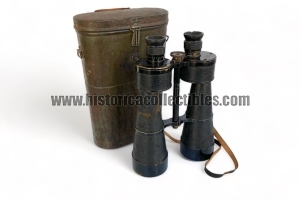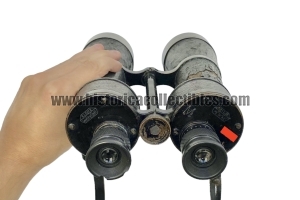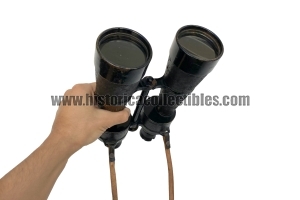Binoculars 12x60 Ernst Leitz Wetzlar, Kaiserliche Marine "M", circa 1917
Binoculars 12x60 made by Leitz in Wetzlar around 1917, to be intended for the Observatories and Commanders of the Kaiserliche Marine.
The binoculars, Porro II, are equipped with 12x magnification with 60mm objective lenses which provide the observer with a field of view of 75m/1000. On the left eyepiece plate there is the mark of the manufacturer E. Leitz Wetzlar, while on the right eyepiece plate there are the marks of the specifications of the binoculars "12 x L25 - 75 = 4.3°" where 12 are the magnifications, L25 with all probability the focal length, 75 are the meters of the field of view and 4.3 are the degrees of the field of view. In addition to these we also find the "M", probably referring to the acceptance by the Kaiserliche Marine (but it is not entirely clear why at the same time a version with the "Crowned M" and a version only with "M"), and finally the 3-digit military assignment number XXX. There is also the "E=13.3 G" mark on the body of the binoculars, the meaning of which we are not yet aware of.
Completely built in solid marine brass, it is complete with its particular metal case, all excellently preserved.
The binoculars are perfectly collimated and the view is clear and bright thanks also to their large 60 mm objective lenses.
History of Ernst Leitz:
Originally called the Optisches Institut, Leica was founded as a small optical workshop in Wetzlar, Germany in 1849. The founder, a German mechanic named Carl Kellner, was intrigued by the advent of microscopes at the time and wanted to establish a factory that produced devices better than its competition.
His hard work soon paid off when in 1851 his laboratory gained popularity for producing high-quality microscopes. Production and sales were severely affected in the years following the owner's sudden death in 1855.
Ernst Leitz joined the company in 1864 as an employee and assumed complete authority after the death of Frederic Belthle, an apprentice hired by Carl Kellner. He later added his full name to the company name in 1869. After immense success in the microscope business, the company opened its first international retail outlet in New York City in 1892. Under Leitz's rule, the small Wetzlar laboratory transformed into a large factory and annual production rose to 4,000 microscopes in 1890.
After establishing a loyal customer base, Ernst Leitz – Optisches Institut – Wetzlar began producing "Binocle 6x18" binoculars at its Wetzlar location in 1907, which laid the foundation for Leica Sport Optics. The binoculars were later followed by high-quality spotting scopes. By the 1960s, Leica binoculars had gained so much admiration that NASA decided to send the Leica Trinovid to the Moon aboard the Apollo mission in 1969.
An optical engineer named Oskar Barnack joined Leica in 1911 to work on binoculars. In his spare time and using company resources, he developed the first working model of a portable camera that used 35mm photographic film.
The device was called the Leitz Camera, named after the CEO, Dr. Ernst Leitz II. The camera became an instant hit among the masses, and Leitz officially added it to the company's product line. Considering the high popularity of the Leica camera range, the company was renamed Leica in 1986, using "Lei" from Leitz and "ca" from the camera.





